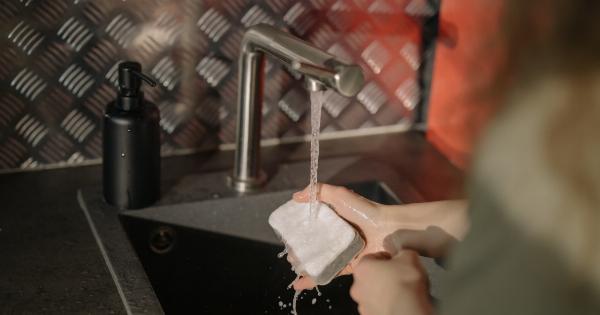Dish sponges are one of the most common things in the kitchen, used to clear out tough stains and grease from dishes, glasses, pots and pans.
While they may look clean and fresh, dish sponges can be breeding grounds for germs and bacteria when used regularly without the proper cleaning. Below are 30 tricks to help you kill germs in your dish sponge and keep your kitchen and dishes clean and sanitary.
1. Microwave Your Sponge
One of the common and most convenient ways to kill germs in your dish sponge is to microwave it for few seconds.
2. Soak dish sponge in Vinegar
Vinegar is an effective home remedy to kill germs in your dish sponge. You can soak your sponge in vinegar for 30 minutes and rinse it with cold water after the soak.
3. Use a High-Quality Dish Soap
Using a high-quality dish soap can help kill germs in the sponge along with cleaning your dishes.
4. Rinse your Sponge after Each Use
Make sure you rinse your sponge thoroughly after each use, and then wring it out to eliminate excess water. This will help to hindrance germs and bacteria growth.
5. Replace Your Sponge Frequently
Replace your sponge frequently, it is suggested to change your sponge every week to discard germs and bacteria growth.
6. Use Bleach to Disinfect Your Sponge
Bleach helps to disinfect your sponge. You can mix 1 tablespoon of bleach with 1/4 cup of water and soak your sponge for 5 minutes. Rinse your sponge well after soaking.
7. Use Hydrogen Peroxide
Hydrogen Peroxide is a proven disinfectant. Mix equal amounts of Hydrogen Peroxide and water and let the sponge soak for some minutes. Rinse thoroughly after soaking.
8. Use Tea Tree Oil
Tea tree oil is an effective natural cleaner. Add 5-10 drops of tea tree oil to water, soak your sponge for few minutes, and rinse it well. It helps to disinfect the sponge and eliminate germs.
9. Wash Sponge in Dishwasher
You can wash your sponge in the dishwasher to help destroy germs. Run the sponge in a hot water cycle and dry it immediately after the wash to prevent further bacteria growth.
10. Boil Your Sponge
Boiling your sponge is an effective way to destroy germs and bacteria. Boil your sponge in a pot of water for 5 to 10 minutes. Rinse thoroughly after boiling.
11. Use Salt to Cleanse Sponge
Salt is a natural cleanser that can help to eliminate germs in your sponge. Wet the sponge and sprinkle salt, let the salt sit on the sponge for a few hours and rinse it well.
12. Lemon Juice to Clean Sponge
Lemon juice is a natural disinfectant that can help to eliminate germs and bacteria from your sponge. Squeeze lemon juice on your sponge and let it soak for few minutes before rinsing it with cold water.
13. Use Baking Soda
Baking soda is a natural cleanser that can help to eliminate germs in your dish sponge. Dip your sponge in baking soda and water mixture or sprinkle baking soda on the surface of the sponge and let it sit for few minutes, rinse it thoroughly after.
14. Create a Homemade Cleaning Solution
A homemade cleaning solution can help to clean and disinfect your sponge. Mix a tablespoon of dish soap, one tablespoon of vinegar, and one cup of boiling water.
Soak your sponge for 5-10 minutes, rinse the sponge with warm water, and soak it again in cold water.
15. Use Rubbing Alcohol
Rubbing alcohol can be a quick germ deterrent. Saturate your sponge in rubbing alcohol for a few minutes and rinse it well.
16. Use Dishwasher Detergent
Dishwasher detergent can be used to clean and disinfect the sponge. Soak your sponge in the dishwashing detergent solution for 5-10 minutes, rinse it well, and dry it in a well-ventilated area.
17. Use Solid Dish Soap
Solid dish soap can also be used to clean your sponge. Moisten the sponge and rub it on the solid dish soap, rinse it with warm water, and let it dry thoroughly before storage.
18. Store Sponge in Antibacterial Dish Soap
After cleaning your sponge, you can store it in an antibacterial dish soap, which will help to prevent additional germ buildup. The dish soap will prevent bacteria from developing on the sponge surface.
19. Use Borax Powder
Borax powder can also be used to clean and sanitize your sponge. Soak your sponge in a mixture of borax powder and water for at least 10-15 minutes and rinse it well.
20. Use Epsom Salt
Epsom salt can be used as an effective cleaner in cleaning germ-infested sponges. Soak your sponge in a bowl of warm water with Epsom salt and vinegar for 5-10 minutes and rinse it thoroughly in cold water.
21. Use Essential Oils
Essential oils can assist in cleaning your sponge. Add three drops of essential oil, such as lavender or peppermint, to a mixture of warm water and vinegar, and soak your sponge for a few minutes, rinse thoroughly.
22. Use Sodium Bicarbonate
Sodium bicarbonate can also work as an effective disinfectant agent to clean germs-infested sponges. Mix sodium bicarbonate with warm water and soak your sponge for at least 3-5 minutes and rinse well.
23. Use Lemon & Salt
Using the combination of lemon and salt can aid in disinfecting your sponge. Cut one or two lemons in half and pour salt on the top, then rub the sponge over it while squeezing the lemon juice. Rinse thoroughly in cold water.
24. Use Hot Water
Hot water can work as a disinfectant when washing your sponge. After cleaning the dishes with the sponge, run hot water through the sponge and rinse it thoroughly to kill any remaining germs.
25. Use Steam Cleaner
Using a steam cleaner to clean your sponge is a great way to kill germs. The heat generated from the steam cleaner will eliminate germs and bacteria without chemicals.
26. Use Sanitizer Spray
You can also use a sanitizer spray to protect your sponge from germs. Spray it on the sponge and let sit for a few minutes before rinsing it with water.
27. Use Salt and Vinegar
Mix salt and vinegar to create a natural cleaning solution to kill the germs in your sponge. Soak your sponge in the solution for 10-15 minutes and rinse it thoroughly.
28. Use Lime Juice
Lime juice has antibacterial properties that can help to eliminate germs in your sponge. Squeeze the juice of the lime into a bowl of warm water and soak your sponge for a few minutes.
29. Use Castile Soap
Castile soap is a natural cleaner that can work as a disinfectant agent to eliminate germs. Mix the castile soap with water and soak your sponge for 10-15 minutes, rinse well with cold water.
30. Use White Vinegar and Baking Soda
White vinegar and baking soda can be mixed to create an effective cleaner to eliminate germs and bacteria from your sponge. Soak your sponge in white vinegar and baking soda solution for 1 to 2 hours and rinse it well.































